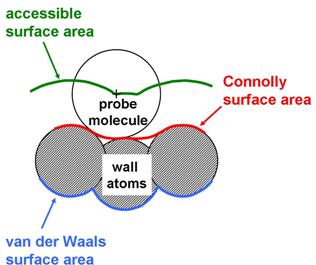Surface area program
Calculating the accessible surface area
The accessible surface area is a geometric method to determine the surface area of a solid. It is calculated from the centre of a probe molecule rolling along the surface as illustrated below. The accessible surface area is a useful property to calculate in order to characterise a porous solid for adsorption applications. In the medium coverage range, the amount adsorbed is proportional to the accessible surface area calculate with a probe diameter corresponding to the adsorbate of interest and therefore allows assessing the relative adsorption perfomrance of different porous solids (see H.Frost, T. Düren, R.Q. Snurr, J. Phys. Chem. B, 2006, 110, 9565 ). Calculated with a nitrogen sized probe molecule, it compares very well with the BET surface area determined with the consistency criteria for good quality samples (for a description of how to determine the pressure range where the BET method is valid, see e.g. F. Rouquerol, J. Rouquerol & K.Sing, "Adsorption by Powders and Porous Solids", Academic Press, 1999, page 168). Therefore, it provides an easy way to get information about the quality of a synthesised sample: if the experimentally determined BET surface area deviates significantly from the accessible surface, it is an indication that the cavities of the sample are not completely empty or accessible. For a full discussion why the accessible surface area rather than the Connolly surface area is the approbriate surface area to characterise porous solids for adsorption applications, see T. Düren, F. Millange, G. Ferey, K.S. Walton, R.Q. Snurr, J. Phys. Chem. C, 2007, 111, 15360.The accessible surface area is calculated from a simple Monte Carlo integration technique where the probe molecule is "rolled" over the framework surface. For this a probe molecule is randomly inserted around each of the framework atoms in turn and checked for overlap with other frameworl atoms. The fraction of the probe molecules that does not overlap with other framework atoms is then used to calculate the accessible surface area.
Obtaining the code
The accessible surface area code is available under the General Public Licence. Read the conditions of the license before proceeding with the download .Different versions of the code
There are different versions of the code available- For orthorhombic unit cells
This is the original version of the code. If you want to understand how the algorithm works this is the best starting point. It is also faster than the non-orthorhombic version but only works for orthorhomic unit cells. - For non-orthorhombic unit cells
This version works for both orthorhombic and non-orthorhombic unit cells. If you are working with large orthorhombic unit cells it might be quicker if you use the other version. This version uses an xyz-file as input for the crystal coordinates.
Please note that for all versions, you need a unit cell containing all coordinates (i.e. P1). The programs do not handle symmetry operations.
